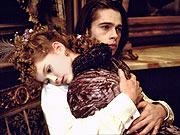So, since: a) no one reads this blog, and b) I am not currently writing anything outside of my classes, I have decided to do something of an archaeological dig into my "creative past." I am searching my archive for all things written and I will post it. It will be embarrassing and it will be true.
Talk About Infantilization:
... But really, I want to talk about it. This seems to be a common theme in the Gothic, no? A man takes control of a woman's life and forces her into the role of the child no matter the age, forming a somewhat incestuous bond.
We see it in Charlotte Gilman's, The Yellow Wallpaper, where the unnamed narrator is trapped in a nursery by her husband. We are brought along as her mind deteriorates into the childish nature she's being forced to inhabit. In this case she is a grown woman who's husband treats her as both his child and his wife, creating a more symbolic concept of incest.
Last night (early this morning) I watched Interview with the Vampire: The Vampire Chronicles (1994). In this contemporary Gothic we see a physical representation of an infantilized woman. Claudia is turned into a vampire by Lestat when she is only a young girl. She is forced to grow older in years as her body remains in its prepubescent form. Lestat "dresses [her] like a doll," even after she has been a vampire for thirty years. As an adult, Claudia serves as a companion to Louis, however he calls her his daughter. The line between familial and romantic love is blurred when she kisses him on the mouth in their last scene together.
These two stories represent the infantalized women in opposite ways. One, a woman who's mind deteriorates to a childlike state, the other a child who has the mind of an adult. Both are forced into these roles by the oppression of the men in their lives, and their need to feel superior and masculine in comparison.
Subscribe to:
Post Comments (Atom)

No comments:
Post a Comment